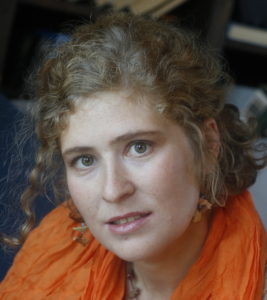Good practices
Studying mathematics on learning tables
 Technological innovations rapidly transform our educational routines, but in which cases do these innovations contribute to the understanding of mathematical concepts? Anna Shvarts (researcher at the Freudenthal Institute) is exploring the effect of interactive mathematics activities on conceptual understanding of students, with the learning tables in the TLL.
Technological innovations rapidly transform our educational routines, but in which cases do these innovations contribute to the understanding of mathematical concepts? Anna Shvarts (researcher at the Freudenthal Institute) is exploring the effect of interactive mathematics activities on conceptual understanding of students, with the learning tables in the TLL.
“My research aims to create interactive educational designs that would allow a wide range of students to study mathematics with engagement and joy and arrive at conceptual understanding. Thus my research seeks to make mathematics meaningful and applicable for everyday tasks for all students,” Anna explains.
Learning tables
Anna’s interactive designs are also accessible through tablets, but she uses the learning tables, because they provide an entire-body experience. This gives more opportunities for both the students and the researcher. “When about a year ago I first opened interactive activities for mathematics learning on a learning table, I felt like I was in a classroom of the future. Learning tables provide a unique chance to experience mathematical concepts, such as parabola or sine graphs, with your entire body as you study it with two hands on a large screen. This is a kind of experience that stays in your body and forms your mind.”
Sensory-motor process
It is not easy to introduce new computer tools in students’ mathematics learning process in a way that these tools would contribute to mathematical thinking. Anna hypothesizes that “educational activities that require motor manipulation (embodied processes) can provide the student with sensory-motor experience which later help in the appropriation of computer tools in a meaningful way: students coordinate mathematical problem solving with technological media, and finally, computer tools foster mathematics learning. However, only sensory-motor coordination is not sufficient: a reflection on the just enacted action in conversation with the teacher is necessary to transform motor actions into mathematical action.”
Preliminary results
Anna studies the perceptual and problem-solving strategies of the students by eye-tracking and videography. The research is still in progress, but “we come to understand that technological tools become a congruent part of student’s mathematical thinking in the case that students establish some coordination in their motor routine, and later this coordination is outsourced to the computer system and becomes a part of the tool. For example, students need to develop coordination between the length of a unit circle arch and some distance on the x-axis on a Cartesian plane by themselves, and only then a point on a unit circle and on a sine graph can be automatically aligned by a computer system. Otherwise, a technological tool appears to the students as a black box.”
More research in the TLL
Anna will collect more research data in the TLL. “The TLL laboratory is perfectly equipped with everything that I need in my research: tables with adjustable height, additional sockets, lamps, chairs, and so on. Everything is easily accessible, flexible, and adjustable. The ergonomics of learning tables that can be adjusted in multiple directions (height, rotation angle) make it convenient equipment.”
Author: Miranda Overbeek (Freudenthal Institute)


